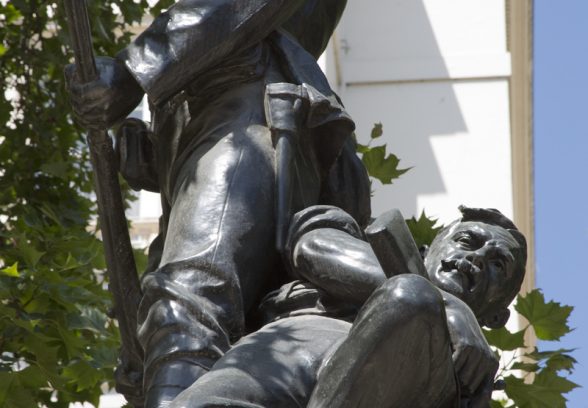This website uses cookies
This website uses cookies to enable it to function properly and to analyse how the website is used. Please click 'Close' to accept and continue using the website.



London: Royal Marine National Memorial
Status: Listed Grade II
Architect: Thomas Graham Jackson & Captain Adrian Jones (Sculpture), 1903
Location: The Mall, London
This memorial, like many others in London has had a decidedly turbulent history; it was constructed in 1903 to the Royal Marines killed in South Africa and China. During WWII, the memorial was stored at the yard of Holloway Bros in Nine Elms after its removal from St James Park. As with the Lutyens memorial, it was removed for the construction of the Citadel. After the war is was moved to the grounds of the Royal Hospital in Chelsea and was moved back to its present site in 1948. The memorial suffered slight bomb damage in 1940, but was restored by 1948. As part of the Millennium Year Initiative in 2000, the monument was fully restored. One of the major contributors to the restoration was the government of the Falkland Islands, whose donation of £15,000 honoured the two-century-long relationship between the Islands and the Royal Marines. The sculpture shows a wounded marine being defended by a fellow soldier, his levelled rifle and bayonet suggesting an imminent attack. The pedestal has inscribed bronze plaques and on two sides, reliefs depict action at both Graspan (Boer) and the repulse of the Chinese attack on the Peking Legations – a little-remembered conflict that involved the Royal Marines. The carved dolphins on each corner symbolise the marines as a naval force.
Jones (1845-1938), was born in Ludlow, Shropshire and studied at the Royal Veterinary College, qualifying in 1866 as a veterinary surgeon, and enrolling in the Army as a veterinary officer in the Royal Artillery the following year. He served from 1867 to 1890 seeing service during the Abyssinian Expedition of 1868 before joining the 3rd Hussars in 1869. From 1871 to 1881 he served with the Queen’s Bays in Ireland and was then attached to the 7th Hussars and fought with them in the Anglo-Transvaal war in 1881. In South Africa he was attached to the Inskilling Dragoons. In 1884 Jones served in Egypt where he selected camels for the Nile Expedition of 1884 and finally joined the 2nd Life Guards and retired in 1890 with the rank of captain.
After this distinguished military career, and with no formal training as an artist, he set himself up in a studio in Chelsea. Due to his profound knowledge of equine physiology and anatomy he specialised in horse sculpture, his best known example being Peace in her Quadriga (four horse chariot). At 40- tonnes this is the largest Bronze sculpture in Britain and stands atop Decimus Burton’s Wellington Arch at Hyde Park Corner. Other notable works include the superb Cavalry Memorial in Hyde Park (1906), with St George triumphant over a rather crocodilian dragon and the fine equestrian statue of Sir Redvers Henry Buller in Exeter (1905).
Jon Wright
Either enter the name of a place or memorial or choose from the drop down list. The list groups memorials in London and then by country

Become a C20 member today and help save our modern design heritage.